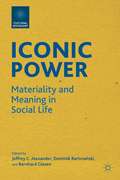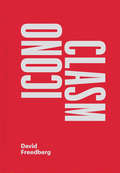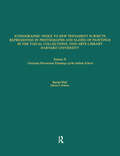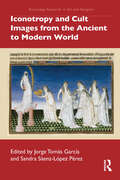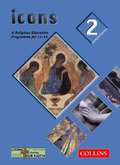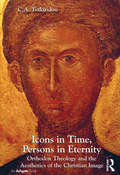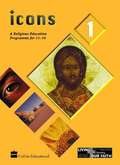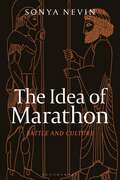- Table View
- List View
Ice Cream Queen of Orchard Street: A Novel
by Susan Jane GilmanA clever and complex woman builds an ice cream empire after immigrating from Russia in this stunning novel of power, Prohibition, and performance set against the backdrop of early 20th-century America. In 1913, little Malka Treynovsky flees Russia with her family. Bedazzled by tales of gold and movie stardom, she tricks them into buying tickets for America. Yet no sooner do they land on the squalid Lower East Side of Manhattan, than Malka is crippled and abandoned in the street. Taken in by a tough-loving Italian ices peddler, she manages to survive through cunning and inventiveness. As she learns the secrets of his trade, she begins to shape her own destiny. She falls in love with a gorgeous, illiterate radical named Albert, and they set off across America in an ice cream truck. Slowly, she transforms herself into Lillian Dunkle, "The Ice Cream Queen" -- doyenne of an empire of ice cream franchises and a celebrated television personality. Lillian's rise to fame and fortune spans seventy years and is inextricably linked to the course of American history itself, from Prohibition to the disco days of Studio 54. Yet Lillian Dunkle is nothing like the whimsical motherly persona she crafts for herself in the media. Conniving, profane, and irreverent, she is a supremely complex woman who prefers a good stiff drink to an ice cream cone. And when her past begins to catch up with her, everything she has spent her life building is at stake.
Icon of Evil: Hitler's Mufti and the Rise of Radical Islam
by David DalinA chilling, fascinating, and nearly forgotten historical figure is resurrected in this riveting work that links the fascism of the last century with the terrorism of our own. Written with vigor and extraordinary access to primary sources in several languages, Icon of Evil is the definitive account of the man who, during World War II, was called "the fuhrer of the Arab world" and whose ugly legacy lives on today.With new and disturbing details, David G. Dalin and John F. Rothmann show how al -Husseini ingratiated himself with his hero, Adolf Hitler, becoming, with his blond hair and blue eyes, an "honorary Aryan" while dreaming of being installed as Nazi leader of the Middle East. Al-Husseini would later recruit more than 100,000 Muslims in Europe to fight in divisions of the Waffen- SS, and obstruct negotiations with the Allies that might have allowed four thousand Jewish children to escape to Palestine. Some believe that al-Husseini even inspired Hitler to implement the Final Solution. At war's end, al-Husseini escaped indictment at Nuremberg and was harbored in France.Icon of Evil chronicles al-Husseini's postwar relationships with such influential Islamic figures as the radical theoretician Sayyid Qutb and Saddam Hussein's powerful uncle General Khairallah Talfah and his crucial mentoring of the young Yasser Ararat. Finally, it provides compelling evidence that al-Husseini's actions and writings serve as inspirations today to the leaders of Hamas, Hezbollah, and other terrorist organizations pledged to destroy Israel and the United States.
Icon of Evil: Hitler's Mufti and the Rise of Radical Islam
by David DalinA chilling, fascinating, and nearly forgotten historical figure is resurrected in this riveting work that links the fascism of the last century with the terrorism of our own. Written with vigor and extraordinary access to primary sources in several languages, Icon of Evil is the definitive account of the man who, during World War II, was called "the fuhrer of the Arab world" and whose ugly legacy lives on today.With new and disturbing details, David G. Dalin and John F. Rothmann show how al -Husseini ingratiated himself with his hero, Adolf Hitler, becoming, with his blond hair and blue eyes, an "honorary Aryan" while dreaming of being installed as Nazi leader of the Middle East. Al-Husseini would later recruit more than 100,000 Muslims in Europe to fight in divisions of the Waffen- SS, and obstruct negotiations with the Allies that might have allowed four thousand Jewish children to escape to Palestine. Some believe that al-Husseini even inspired Hitler to implement the Final Solution. At war's end, al-Husseini escaped indictment at Nuremberg and was harbored in France.Icon of Evil chronicles al-Husseini's postwar relationships with such influential Islamic figures as the radical theoretician Sayyid Qutb and Saddam Hussein's powerful uncle General Khairallah Talfah and his crucial mentoring of the young Yasser Ararat. Finally, it provides compelling evidence that al-Husseini's actions and writings serve as inspirations today to the leaders of Hamas, Hezbollah, and other terrorist organizations pledged to destroy Israel and the United States.
The Iconic Imagination
by Douglas HedleyIs it merely an accident of English etymology that 'imagination' is cognate with 'image'? Despite the iconoclasm shared to a greater or lesser extent by all Abrahamic faiths, theism tends to assert a link between beauty, goodness and truth, all of which are viewed as Divine attributes. Douglas Hedley argues that religious ideas can be presented in a sensory form, especially in aesthetic works. Drawing explicitly on a Platonic metaphysics of the image as a bearer of transcendence, The Iconic Imagination shows the singular capacity and power of images to represent the transcendent in the traditions of Christianity, Judaism, Hinduism and Islam. In opposition to cold abstraction and narrow asceticism, Hedley shows that the image furnishes a vision of the eternal through the visible and temporal.
The Iconic Imagination
by Douglas HedleyIs it merely an accident of English etymology that 'imagination' is cognate with 'image'? Despite the iconoclasm shared to a greater or lesser extent by all Abrahamic faiths, theism tends to assert a link between beauty, goodness and truth, all of which are viewed as Divine attributes. Douglas Hedley argues that religious ideas can be presented in a sensory form, especially in aesthetic works. Drawing explicitly on a Platonic metaphysics of the image as a bearer of transcendence, The Iconic Imagination shows the singular capacity and power of images to represent the transcendent in the traditions of Christianity, Judaism, Hinduism and Islam. In opposition to cold abstraction and narrow asceticism, Hedley shows that the image furnishes a vision of the eternal through the visible and temporal.
Iconic Power: Materiality and Meaning in Social Life (Cultural Sociology)
by jeffrey c. alexander, dominik bartma´nski, and bernhard giesenA collection of original articles that explore social aspects of the phenomenon of icon. Having experienced the benefits and realized the limitations of so called 'linguistic turn', sociology has recently acknowledged a need to further expand its horizons.
Iconoclasm
by David FreedbergWith new surges of activity from religious, political, and military extremists, the destruction of images has become increasingly relevant on a global scale. A founder of the study of early modern and contemporary iconoclasm, David Freedberg has addressed this topic for five decades. His work has brought this subject to a central place in art history, critical to the understanding not only of art but of all images in society. This volume collects the most significant of Freedberg’s texts on iconoclasm and censorship, bringing five key works back into print alongside new assessments of contemporary iconoclasm in places ranging from the Near and Middle East to the United States, as well as a fresh survey of the entire subject. The writings in this compact volume explore the dynamics and history of iconoclasm, from the furious battles over images in the Reformation to government repression in modern South Africa, the American culture wars of the early 1990s, and today’s cancel culture. Freedberg combines fresh thinking with deep expertise to address the renewed significance of iconoclasm, its ideologies, and its impact. This volume also provides a supplement to Freedberg’s essay on idolatry and iconoclasm from his pathbreaking book, The Power of Images. Freedberg’s writings are of foundational importance to this discussion, and this volume will be a welcome resource for historians, museum professionals, international law specialists, preservationists, and students.
Iconoclasm
by David FreedbergWith new surges of activity from religious, political, and military extremists, the destruction of images has become increasingly relevant on a global scale. A founder of the study of early modern and contemporary iconoclasm, David Freedberg has addressed this topic for five decades. His work has brought this subject to a central place in art history, critical to the understanding not only of art but of all images in society. This volume collects the most significant of Freedberg’s texts on iconoclasm and censorship, bringing five key works back into print alongside new assessments of contemporary iconoclasm in places ranging from the Near and Middle East to the United States, as well as a fresh survey of the entire subject. The writings in this compact volume explore the dynamics and history of iconoclasm, from the furious battles over images in the Reformation to government repression in modern South Africa, the American culture wars of the early 1990s, and today’s cancel culture. Freedberg combines fresh thinking with deep expertise to address the renewed significance of iconoclasm, its ideologies, and its impact. This volume also provides a supplement to Freedberg’s essay on idolatry and iconoclasm from his pathbreaking book, The Power of Images. Freedberg’s writings are of foundational importance to this discussion, and this volume will be a welcome resource for historians, museum professionals, international law specialists, preservationists, and students.
Iconoclasm As Child's Play
by Joe MoshenskaWhen sacred objects were rejected during the Reformation, they were not always burned and broken but were sometimes given to children as toys. Play is typically seen as free and open, while iconoclasm, even to those who deem it necessary, is violent and disenchanting. What does it say about wider attitudes toward religious violence and children at play that these two seemingly different activities were sometimes one and the same? Drawing on a range of sixteenth-century artifacts, artworks, and texts, as well as on ancient and modern theories of iconoclasm and of play, Iconoclasm As Child's Play argues that the desire to shape and interpret the playing of children is an important cultural force. Formerly holy objects may have been handed over with an intent to debase them, but play has a tendency to create new meanings and stories that take on a life of their own. Joe Moshenska shows that this form of iconoclasm is not only a fascinating phenomenon in its own right; it has the potential to alter our understandings of the threshold between the religious and the secular, the forms and functions of play, and the nature of historical transformation and continuity.
Iconographic Index to New Testament Subjects Represented in Photographs and Slides of Paintings in the Visual Collections, Fine Arts Library, Harvard University: Christian Devotional Paintings of the Italian School
by Rachel Hall Helene E. RobertsThis vast reference resource will appeal to anyone who wishes to find depictions of New Testament narratives from scholars, to students, to picture researchers. The first part of the book consists of a list of proper names, terms, and concepts relating to New Testament narratives represented. Under each name, term or concept, the ICONCLASS alphanumeric codes are entered, along with a brief description of the New Testament scenes in which the characters or actions occur. The second part of this text is organized according to the ICONCLASS alphanumeric codes, their order reflecting the Biblical sequence of narrative.
Iconographic Index to New Testament Subjects Represented in Photographs and Slides of Paintings in the Visual Collections, Fine Arts Library, Harvard University: Christian Devotional Paintings of the Italian School
by Rachel Hall with Helene E. RobertsThis vast reference resource will appeal to anyone who wishes to find depictions of New Testament narratives from scholars, to students, to picture researchers. The first part of the book consists of a list of proper names, terms, and concepts relating to New Testament narratives represented. Under each name, term or concept, the ICONCLASS alphanumeric codes are entered, along with a brief description of the New Testament scenes in which the characters or actions occur. The second part of this text is organized according to the ICONCLASS alphanumeric codes, their order reflecting the Biblical sequence of narrative.
Iconotropy and Cult Images from the Ancient to Modern World (Routledge Research in Art and Religion)
by Jorge Tomás GarcíaThe book examines the process of symbolic and material alteration of religious images in antiquity, the middle ages and the modern period. The process by which the form and meaning of images are modified and adapted for a new context is defined by a large number of spiritual, religious, artistic, geographical or historical circumstances. This book provides a defined theoretical framework for these symbolic and material alterations based on the concept of iconotropy; that is, the way in which images change and/or alter their meaning. Iconotropy is a key concept in religious history, particularly for periods in which religious changes, often turbulent, took place. In addition, the iconotropic process of appropriating cult images brought with it changes in the materiality of those images. Numerous accounts from antiquity, the middle ages and the modern period detail how cult images were involved in such processes of misinterpretation, both symbolically and materially.The book will be of interest to scholars working in art history, visual culture and religious history.
Iconotropy and Cult Images from the Ancient to Modern World (Routledge Research in Art and Religion)
by Jorge Tomás García Sandra Sáenz-López PérezThe book examines the process of symbolic and material alteration of religious images in antiquity, the middle ages and the modern period. The process by which the form and meaning of images are modified and adapted for a new context is defined by a large number of spiritual, religious, artistic, geographical or historical circumstances. This book provides a defined theoretical framework for these symbolic and material alterations based on the concept of iconotropy; that is, the way in which images change and/or alter their meaning. Iconotropy is a key concept in religious history, particularly for periods in which religious changes, often turbulent, took place. In addition, the iconotropic process of appropriating cult images brought with it changes in the materiality of those images. Numerous accounts from antiquity, the middle ages and the modern period detail how cult images were involved in such processes of misinterpretation, both symbolically and materially.The book will be of interest to scholars working in art history, visual culture and religious history.
Icons – Student’s Book 2 (PDF)
by Mary Jo MartinIcons is a complete Key Stage 3 RE programme developed by the National Project and published with the authority of the Catholic Bishops’ Conference of England and Wales.
Icons in Time, Persons in Eternity: Orthodox Theology and the Aesthetics of the Christian Image
by C.A. TsakiridouIcons in Time, Persons in Eternity presents a critical, interdisciplinary examination of contemporary theological and philosophical studies of the Christian image and redefines this within the Orthodox tradition by exploring the ontological and aesthetic implications of Orthodox ascetic and mystical theology. It finds Modernist interest in the aesthetic peculiarity of icons significant, and essential for re-evaluating their relationship to non-representational art. Drawing on classical Greek art criticism, Byzantine ekphraseis and hymnography, and the theologies of St. Maximus the Confessor, St. Symeon the New Theologian and St. Gregory Palamas, the author argues that the ancient Greek concept of enargeia best conveys the expression of theophany and theosis in art. The qualities that define enargeia - inherent liveliness, expressive autonomy and self-subsisting form - are identified in exemplary Greek and Russian icons and considered in the context of the hesychastic theology that lies at the heart of Orthodox Christianity. An Orthodox aesthetics is thus outlined that recognizes the transcendent being of art and is open to dialogue with diverse pictorial and iconographic traditions. An examination of Ch’an (Zen) art theory and a comparison of icons with paintings by Wassily Kandinsky, Pablo Picasso, Mark Rothko and Marc Chagall, and by Japanese artists influenced by Zen Buddhism, reveal intriguing points of convergence and difference. The reader will find in these pages reasons to reconcile Modernism with the Christian image and Orthodox tradition with creative form in art.
Icons in Time, Persons in Eternity: Orthodox Theology and the Aesthetics of the Christian Image
by C.A. TsakiridouIcons in Time, Persons in Eternity presents a critical, interdisciplinary examination of contemporary theological and philosophical studies of the Christian image and redefines this within the Orthodox tradition by exploring the ontological and aesthetic implications of Orthodox ascetic and mystical theology. It finds Modernist interest in the aesthetic peculiarity of icons significant, and essential for re-evaluating their relationship to non-representational art. Drawing on classical Greek art criticism, Byzantine ekphraseis and hymnography, and the theologies of St. Maximus the Confessor, St. Symeon the New Theologian and St. Gregory Palamas, the author argues that the ancient Greek concept of enargeia best conveys the expression of theophany and theosis in art. The qualities that define enargeia - inherent liveliness, expressive autonomy and self-subsisting form - are identified in exemplary Greek and Russian icons and considered in the context of the hesychastic theology that lies at the heart of Orthodox Christianity. An Orthodox aesthetics is thus outlined that recognizes the transcendent being of art and is open to dialogue with diverse pictorial and iconographic traditions. An examination of Ch’an (Zen) art theory and a comparison of icons with paintings by Wassily Kandinsky, Pablo Picasso, Mark Rothko and Marc Chagall, and by Japanese artists influenced by Zen Buddhism, reveal intriguing points of convergence and difference. The reader will find in these pages reasons to reconcile Modernism with the Christian image and Orthodox tradition with creative form in art.
Icons of Unbelief: Atheists, Agnostics, and Secularists (Greenwood Icons)
by S. T. JoshiDiscusses the ideas and impact of 27 atheists, agnostics, and secularists whose ideas have shaped society over the last 200 years.In the opinion of many critics and philosophers, we are entering an age of atheism marked by the waning of Christian fundamentalism and the flourishing of secular thought. Through alphabetically arranged entries written by expert contributors, this book profiles 27 iconic figures of unbelief whose ideas have shaped American society over the last 200 years. Included are entries on influential figures of the past, such as Albert Einstein and Voltaire, as well as on such contemporary figures as Richard Dawkins and Sam Harris. Each entry discusses the ideas and lasting significance of each person or group, provides sidebars of interesting information and illuminating quotations, and cites works for further reading. The volume closes with a selected, general bibliography. Students in social studies and history classes will welcome this reference as a guide to the ideas central to the American separation of Church and State and to many of the political debates at the heart of society today.Each entry discusses the ideas and lasting significance of the person or group, provides sidebars of interesting information and quotations, and closes with a list of works for further reading. The volume ends with a selected, general bibliography. Students in history and social studies classes will welcome this reference as a guide to the American separation of Church and State and to the ideas central to contemporary political debates.
Icons (Icons Ser.)
by Mary Jo Martin Ann Brook Tony CastleIcons is a complete Key Stage 3 RE programme developed by the National Project and published with the authority of the Catholic Bishops’ Conference of England and Wales. Icons provides teachers with a programme for Religious Education which is fully in line with the Catholic Bishops’ Curriculum Directory. The straightforward, book-per-year structure is clear and flexible. Each book contains three units which each cover five key areas: Jesus Christ, Human Person, Church, Liturgical Year, Sacraments. Each section of work is studied through a three-fold process: Research, Revelation and Response. The style and layout are accessible and clear, and both teachers and students are provided with specific aims for each section.
The Idea of European Islam: Religion, Ethics, Politics and Perpetual Modernity (Routledge Islamic Studies Series)
by Mohammed HashasSuspicions about the integration of Islam into European cultures have been steadily on the rise, and dramatically so since 9/11. One reason lies in the visibility of anti-Western Islamic discourses of salafi origin, which have monopolized the debate on the "true" Islam, not only among Muslims but also in the eyes of the general population across Europe; these discourses combined with Islamophobic discourses reinforce the so-called incompatibility between the West and Islam. This book breaks away from this clash between Islam and the West, by arguing that European Islam is possible. It analyzes the contribution that European Islam has made to the formation of an innovative Islamic theology that is deeply ethicist and modern, and it clarifies how this constructed European Islamic theology is able to contribute to the various debates that are related to secular-liberal democracies of Western Europe. Part I introduces four major projects that defend the idea of European Islam from different disciplines and perspectives: politics, political theology, jurisprudence and philosophy. Part II uses the frameworks from three major philosophers and scholars to approach the idea of European Islam in the context of secular-liberal societies: British scholar George Hourani, Moroccan philosopher Taha Abderrahmane and the American philosopher John Rawls. The book shows that the ongoing efforts of European Muslim thinkers to revisit the concept of citizenship and political community can be seen as a new kind of political theology, in opposition to radical forms of Islamic thinking in some Muslim-majority countries. Opening a new path for examining Islamic thought "in and of" Europe, this book will appeal to students and scholars of Islamic Studies, Islam in the West and Political Theology.
The Idea of European Islam: Religion, Ethics, Politics and Perpetual Modernity (Routledge Islamic Studies Series)
by Mohammed HashasSuspicions about the integration of Islam into European cultures have been steadily on the rise, and dramatically so since 9/11. One reason lies in the visibility of anti-Western Islamic discourses of salafi origin, which have monopolized the debate on the "true" Islam, not only among Muslims but also in the eyes of the general population across Europe; these discourses combined with Islamophobic discourses reinforce the so-called incompatibility between the West and Islam. This book breaks away from this clash between Islam and the West, by arguing that European Islam is possible. It analyzes the contribution that European Islam has made to the formation of an innovative Islamic theology that is deeply ethicist and modern, and it clarifies how this constructed European Islamic theology is able to contribute to the various debates that are related to secular-liberal democracies of Western Europe. Part I introduces four major projects that defend the idea of European Islam from different disciplines and perspectives: politics, political theology, jurisprudence and philosophy. Part II uses the frameworks from three major philosophers and scholars to approach the idea of European Islam in the context of secular-liberal societies: British scholar George Hourani, Moroccan philosopher Taha Abderrahmane and the American philosopher John Rawls. The book shows that the ongoing efforts of European Muslim thinkers to revisit the concept of citizenship and political community can be seen as a new kind of political theology, in opposition to radical forms of Islamic thinking in some Muslim-majority countries. Opening a new path for examining Islamic thought "in and of" Europe, this book will appeal to students and scholars of Islamic Studies, Islam in the West and Political Theology.
The Idea of Holiness and the Humane Response: A study of the concept of... (Routledge Revivals)
by John ArmstrongFirst Published in 1981, The Idea of Holiness and the Humane Response is a radically innovative book, presenting a critical appraisal of the concept of holiness and its effects. It offers a view of holiness far less favourable than the traditional one, yet its conclusions are by no means purely critical or negative. For it sees certain other elements in Hebrew thought as marvelously rich and fertile, insistently reasserting themselves, but repeatedly overwhelmed by an opposed and stronger passion for the idea of holiness. This book is an interesting read for scholars of religion, social history and psychology.
The Idea of Holiness and the Humane Response: A study of the concept of... (Routledge Revivals)
by John ArmstrongFirst Published in 1981, The Idea of Holiness and the Humane Response is a radically innovative book, presenting a critical appraisal of the concept of holiness and its effects. It offers a view of holiness far less favourable than the traditional one, yet its conclusions are by no means purely critical or negative. For it sees certain other elements in Hebrew thought as marvelously rich and fertile, insistently reasserting themselves, but repeatedly overwhelmed by an opposed and stronger passion for the idea of holiness. This book is an interesting read for scholars of religion, social history and psychology.
The Idea of Marathon: Battle and Culture
by Sonya NevinThe Battle of Marathon changed the course of history in ancient Greece. To many, the impossible seemed to have been achieved - the mighty Persian Empire halted in its advance. What happened that day, why was the battle fought, and how did people make sense of it? This bold new history of the battle examines how the conflict unfolded and the ideas attached to it in antiquity and beyond. Many thought the battle offered lessons in how people should behave, with heroism to be emulated and faults to be avoided. While the battle itself was fought in one day, the battle for the idea of Marathon has lasted ever since. After immersing you in the battle, this work will help you to explore how the ancient Athenians used the battle in their relations between themselves and others, and how the battle continued to be used to express ideas about gods, empire, and morality in the age of Alexander and his successors, at Rome and in Greece under the Roman Empire, and in the ages after antiquity, even in our own era, in which Marathon plays a remarkable role in sport, film, and children's literature with each retelling a re-imagining of the battle and its meaning. A clash of weapons, gods, and principles, this is Marathon as you've never seen it before!
The Idea of Marathon: Battle and Culture
by Sonya NevinThe Battle of Marathon changed the course of history in ancient Greece. To many, the impossible seemed to have been achieved - the mighty Persian Empire halted in its advance. What happened that day, why was the battle fought, and how did people make sense of it? This bold new history of the battle examines how the conflict unfolded and the ideas attached to it in antiquity and beyond. Many thought the battle offered lessons in how people should behave, with heroism to be emulated and faults to be avoided. While the battle itself was fought in one day, the battle for the idea of Marathon has lasted ever since. After immersing you in the battle, this work will help you to explore how the ancient Athenians used the battle in their relations between themselves and others, and how the battle continued to be used to express ideas about gods, empire, and morality in the age of Alexander and his successors, at Rome and in Greece under the Roman Empire, and in the ages after antiquity, even in our own era, in which Marathon plays a remarkable role in sport, film, and children's literature with each retelling a re-imagining of the battle and its meaning. A clash of weapons, gods, and principles, this is Marathon as you've never seen it before!
The Idea of Nicaea in the Early Church Councils, AD 431-451 (Oxford Early Christian Studies)
by Mark S. SmithThe Idea of Nicaea in the Early Church Councils examines the role that appeals to Nicaea (both the council and its creed) played in the major councils of the mid-fifth century. It argues that the conflict between rival construals of Nicaea, and the struggle convincingly to arbitrate between them, represented a key dynamic driving—and unsettling—the conciliar activity of these decades. Mark S. Smith identifies a set of inherited assumptions concerning the role that Nicaea was expected to play in orthodox discourse—namely, that it possessed unique authority as a conciliar event, and sole sufficiency as a credal statement. The fundamental dilemma was thus how such shibboleths could be persuasively reaffirmed in the context of a dispute over Christological doctrine that the resources of the Nicene Creed were inadequate to address, and how the convening of new oecumenical councils could avoid fatally undermining Nicaea's special status. Smith examines the articulation of these contested ideas of 'Nicaea' at the councils of Ephesus I (431), Constantinople (448), Ephesus II (449), and Chalcedon (451). Particular attention is paid to the role of conciliar acta in providing carefully-shaped written contexts within which the Nicene Creed could be read and interpreted. This study proposes that the capacity of the idea of 'Nicaea' for flexible re-expression was a source of opportunity as well as a cause of strife, allowing continuity with the past to be asserted precisely through adaptation and modification, and opening up significant new paths for the articulation of credal and conciliar authority. The work thus combines a detailed historical analysis of the reception of Nicaea in the proceedings of the fifth-century councils, with an examination of the complex delineation of theological 'orthodoxy' in this period. It also reflects more widely on questions of doctrinal development and ecclesial reception in the early church.



